
|   |

|   |
 e-mail: sunilkothari1933@gmail.com Nupur: 23rd Classical Dance Festival Photos courtesy: Goa Kala Academy March 26, 2017 The 23rd edition of Nupur, the three-day classical dance festival was flagged off at Shree Mahalsa Sausthan, Mardol-Goa, by Sushant Khedekar, Vice Chairman of Kala Academy, Goa, with other dignitaries on the evening of 18th March 2017. 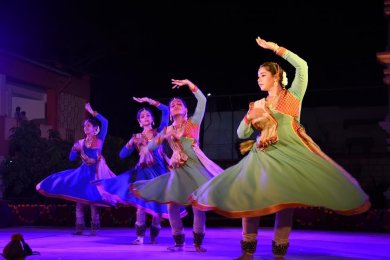 Goa dancers
With the backdrop of the temple with deepa stambh and deepamala, the dance found a devotional ambience. At the very outset, I would like to congratulate the organizers for giving opportunity to young Goan dancers under the guidance of Shama Bhate of Pune in a group choreography of Kathak for four dancers under the scheme of workshop organized by the Directorate of Art and Culture. They included Varada Bedekar, Prerna Palekar, Arpita Shirodkar, Tejaswini Loundo. They did Shama Bhate proud with their neat and unhurried graceful Kathak which consisted of traditional numbers like thaat, aamad, paran, parmelu, bol baant ki tihai and footwork. All of them performed with clarity and confidence. Kajari by Dr. Prabha Atre for abhinaya dwelt upon abhisarika nayika. Music by vocalist Vikrant Naik, Amar Mopkar, and Swapnil Mandrekar (tabla), Prasad Gawas (harmonium), Sonik Velingkar (flute) and recitation by Guru Shama Bhate complimented the dance. Bharatanatyam dancer Neha Bhatnagar from New Delhi, a disciple of Guru Saroja and Rama Vaidyanathan, gave a scintillating performance, with Devi Stuti followed by a varnam in Ritigowla raga in praise of Lord Vishnu, the nayika extolling the virtues of her lord and pining for union with him, beseeching his favour to grant her the boon. Both in nritta and in abhinaya, Neha displayed her virtuosity, elan and skill. For the graceful movements with perfect poses and imaginative approach, she won the appreciation of the audience for her dynamic movements. Meera bhajan saw her in complete immersion of feelings comparing herself as a servant of Krishna, if he were water, she fish, if he were tree, she a cuckoo bird, if he were necklace, she the pearl and so on. The finale with Narayaniyam was captivating creating images of Lord Guruvayurappa. Nattuvangam by Saroja Vaidyanathan, vocal by K. Venkatesh, flute by Rajat Prasanna and mridangam by Thanjavur R. Kesavan was of customary finesse. Neha is a rising star in the firmament of Bharatanatyam. The only thing she has to guard against is creating her individual mannerisms, like Meenakshi Srinivasan, who though trained by Alarmel Valli, displays her own mannerisms. Neha's style reminds one of Rama Vaidyanathan. It is natural that such influence can be seen because of the guru's dominant style. But with passage of time, Neha would do well to evolve her own identity. 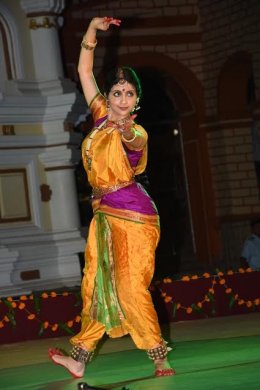 Neha Bhatnagar 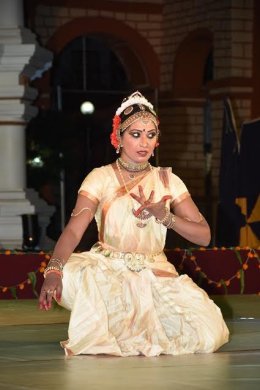 T. Reddi Lakshmi On 19th March, Kuchipudi exponent T. Reddi Lakshmi, disciple of Guru Jayarama Rao, fulfilled the promise of her excellent Kuchipudi. Her lithe body, expressive eyes, mobile visage and lilting movements, suggestive of Vempati Chinna Satyam's style were ample proof of her talent to project the spirit of the maestro's sophisticated bani. Guru Jayarama Rao has polished her movements and in particular Lakshmi's command over tala and laya in Tarangam, performing on edge of a brass plate and alternatively with the same jathis performing on the floor and again on the plate was exquisite. No wonder she received encouraging applause for her dexterity. Patrapravesha daru of Satyabhama saw her in pleasant form. Arrogance, pride, vanity were all displayed in ample measure to portray Satyabhama's character. And in javali, the khandita nayika made it clear to the erring nayaka that she was not one to forgive him for his wayward behaviour dallying with another woman and promising nayika the sky. Without any remorse she closed the doors on him and walked away with pride. The same team of musicians as those of Neha Bhatnagar gave her adequate support with competent nattuvangam by Jayarama Rao. Here is a dancer worth watching. Unfortunately, Maitreyee Pahari's artists of her Lok Chhanda Cultural Unit in their Mayurbhanj Chhau and Kathak presentation to live music did not meet with success, maybe on account of their usual recorded music presentation in contrast to live music. In Kathak, from the beginning dancing in druta and too much speed, the clarity of movements were lost and the artists showed the strain in executing movements. Also there seemed to be tendency of too many chakkars and the feeling of sukun, quiet approach was lost. In Mayurbhanj, despite the good training, the execution of ufli, topka did not jell. Barring Rajesh Saibabu, the other dancers could not maintain balance and symmetry was lost. Their aerial rounds were breathtaking, also falling on floor with split horizontal legs. Nataraja, Dandi, Joddha items were within format of martial spirit. Too much of repetitive movements brought monotony. Instead of three artists performing Nataraja only one could have performed creating impressive movements. Radha Krishna duet in Mayurbhanj and in Kathak was well coordinated. 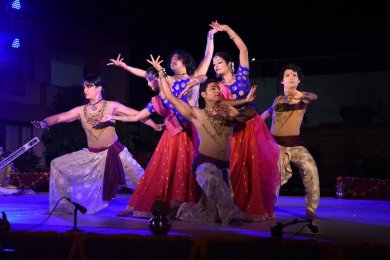
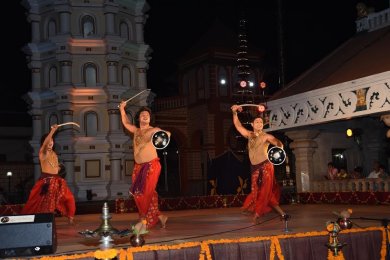
On the final evening of 20th March, Rajendra Gangani's disciple Deepti Gupta in Jaipur gharana style of Kathak under her guru's watchful guidance and training displayed her taiyyari proving that she has enough potential as a skilful dancer who can engage attention of audience on her own. The present day Kathak scenario is facing a big problem. Audiences are now used to speed, excessive chakkars, with the result that the joy of watching Kathak with a feeling of repose is lost. Youth is forgiven for energetic display, virtuosity and taiyyari. But in order to relish the performance, a dancer has to balance the presentation with moderation, with judicious balance between speed and also abhinaya, clarity of movements. All the nritta numbers were performed with vigour and in a faultless technique. But with all that, the performance has to offer rasanubhava. Both Guru Rajendra Gangani and Deepti Gupta would consider this constructive criticism to make Kathak more enjoyable. The accompanying musicians with Guru Rajendra Gangani on padhant and pakhawaj, Mahendra Parihar (vocal), Mayank Bedekar (tabla) and Nafeej on sarangi gave Deepti adequate support. 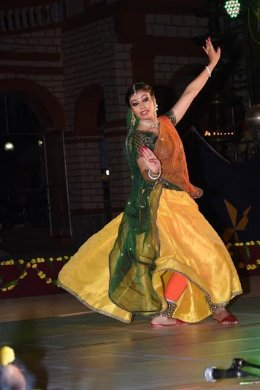 Deepti Gupta 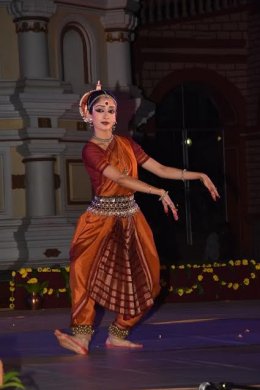 Arushi Mudgal In contrast, Odissi dancer Arushi Mudgal, trained under her aunt Madhavi Mudgal and also Guru Kelucharan Mohapatra, performed with quietude, minus any notable speed, except when it gradually gathers momentum as seen in Shankarabaranam pallavi choreographed by the legendary guru with exquisite music by Bhubaneswar Mishra. Arushi chose to strictly follow Kelubabu's choreographed numbers which were delightful and evoked rasa. Odiya pad "Kede Chhanda" describing Krishna's vanquishing demons like Shakatasura, Dhenukasura, Bakasura, subjugating serpent Kaliya and showing mother Yashoda brahmanda while eating earth had the master's touch that makes creative work memorable. Another pad "Prana sangini re" in which Krishna visits Radha in female costumes to put alta on her feet and mischievously writing his own name as Krishna on her sole, shocks Radha who discovers that Krishna had come in guise of a woman. She is embarrassed and overwhelmed, portraying both emotions in a delectable manner. Arushi did justice to the spirit of the song and Kelubabu's choreography. In Moksha, the final number, the connection with divine spirit and prayer "Narayani namostute" created a peaceful feeling of shanta rasa. The accompanying musicians consisted of Arushi's gifted vocalist sister Sawani Mudgal, Pradipta Kumar Moharana (pakhawaj), Ravinder (flute) and Yar Mohammed (sitar). The compere Dr. Rupa Chari embellished the festival with her poetic commentary.  Dr. Sunil Kothari is a dance historian, scholar, author and critic. He is honored with Padma Shri, Sangeet Natak Akademi award and Senior Critic Award from Dance Critics Association, NYC. Post your comments Please provide your name and email id when you use the Anonymous profile in the blog to post a comment. All appropriate comments posted with name & email id in the blog will also be featured in the site. |